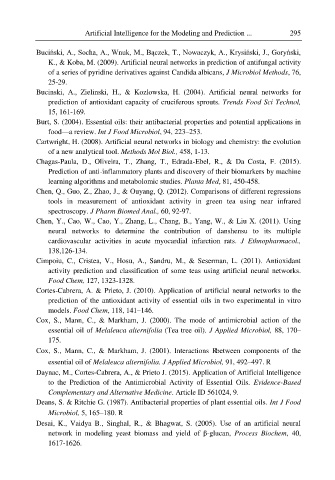Page 314 - Data Science Algorithms in a Week
P. 314
Artificial Intelligence for the Modeling and Prediction ... 295
Buciński, A., Socha, A., Wnuk, M., Bączek, T., Nowaczyk, A., Krysiński, J., Goryński,
K., & Koba, M. (2009). Artificial neural networks in prediction of antifungal activity
of a series of pyridine derivatives against Candida albicans, J Microbiol Methods, 76,
25-29.
Bucinski, A., Zielinski, H., & Kozlowska, H. (2004). Artificial neural networks for
prediction of antioxidant capacity of cruciferous sprouts. Trends Food Sci Technol,
15, 161-169.
Burt, S. (2004). Essential oils: their antibacterial properties and potential applications in
food—a review. Int J Food Microbiol, 94, 223–253.
Cartwright, H. (2008). Artificial neural networks in biology and chemistry: the evolution
of a new analytical tool. Methods Mol Biol., 458, 1-13.
Chagas-Paula, D., Oliveira, T., Zhang, T., Edrada-Ebel, R., & Da Costa, F. (2015).
Prediction of anti-inflammatory plants and discovery of their biomarkers by machine
learning algorithms and metabolomic studies. Planta Med, 81, 450-458.
Chen, Q., Guo, Z., Zhao, J., & Ouyang, Q. (2012). Comparisons of different regressions
tools in measurement of antioxidant activity in green tea using near infrared
spectroscopy. J Pharm Biomed Anal., 60, 92-97.
Chen, Y., Cao, W., Cao, Y., Zhang, L., Chang, B., Yang, W., & Liu X. (2011). Using
neural networks to determine the contribution of danshensu to its multiple
cardiovascular activities in acute myocardial infarction rats. J Ethnopharmacol.,
138,126-134.
Cimpoiu, C., Cristea, V., Hosu, A., Sandru, M., & Seserman, L. (2011). Antioxidant
activity prediction and classification of some teas using artificial neural networks.
Food Chem, 127, 1323-1328.
Cortes-Cabrera, A. & Prieto, J. (2010). Application of artificial neural networks to the
prediction of the antioxidant activity of essential oils in two experimental in vitro
models. Food Chem, 118, 141–146.
Cox, S., Mann, C., & Markham, J. (2000). The mode of antimicrobial action of the
essential oil of Melaleuca alternifolia (Tea tree oil). J Applied Microbiol, 88, 170–
175.
Cox, S., Mann, C., & Markham, J. (2001). Interactions
between components of the
essential oil of Melaleuca alternifolia. J Applied Microbiol, 91, 492–497.
Daynac, M., Cortes-Cabrera, A., & Prieto J. (2015). Application of Artificial Intelligence
to the Prediction of the Antimicrobial Activity of Essential Oils. Evidence-Based
Complementary and Alternative Medicine. Article ID 561024, 9.
Deans, S. & Ritchie G. (1987). Antibacterial properties of plant essential oils. Int J Food
Microbiol, 5, 165–180.
Desai, K., Vaidya B., Singhal, R., & Bhagwat, S. (2005). Use of an artificial neural
network in modeling yeast biomass and yield of β-glucan, Process Biochem, 40,
1617-1626.

